An ANNIVERSARY COMMEMORATION of The Amazing Spider-Man #121 — a comic-book landmark…
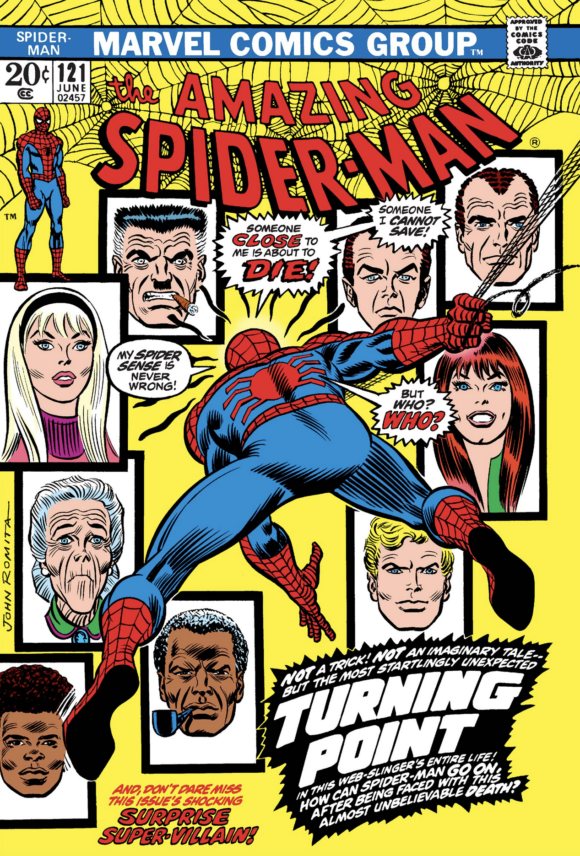
John Romita
By PETER BOSCH
Gwen Stacy died 50 years ago, on March 13, 1973, the day The Amazing Spider-Man #121 was released.
I loved Gwen. Or, to be more precise, I loved the love between Peter Parker and Gwen Stacy.
Borrowing the words of Marvel editor Nick Lowe from the first issue of the 2020 miniseries, Gwen Stacy: “What really drew readers to Gwen was her decency, her compassion, her kindness and her ability to see beyond the surface of things and people. She brought so much joy to the book, characters and readers, and her tragic death made an indelible mark on all things Marvel.”
And, yet, when Peter and Gwen first met (in The Amazing Spider-Man #31, December 1965, which was also the first Harry Osborn appearance), their relationship started with humor for readers.
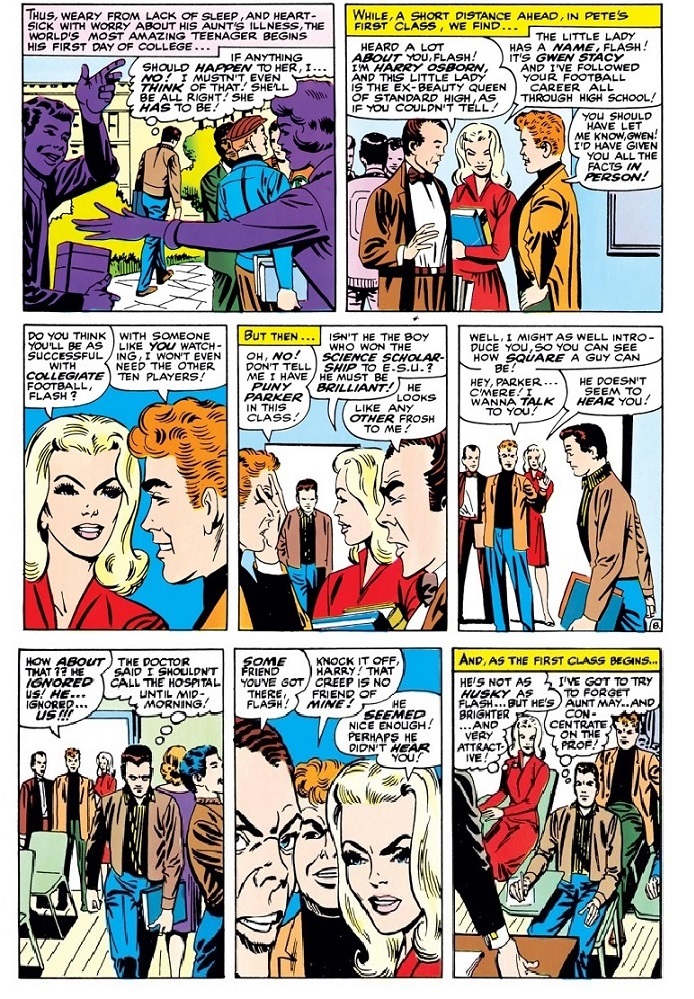
The Amazing Spider-Man #31 (Dec. 1965). Stan Lee, script; Steve Ditko, plot and art.
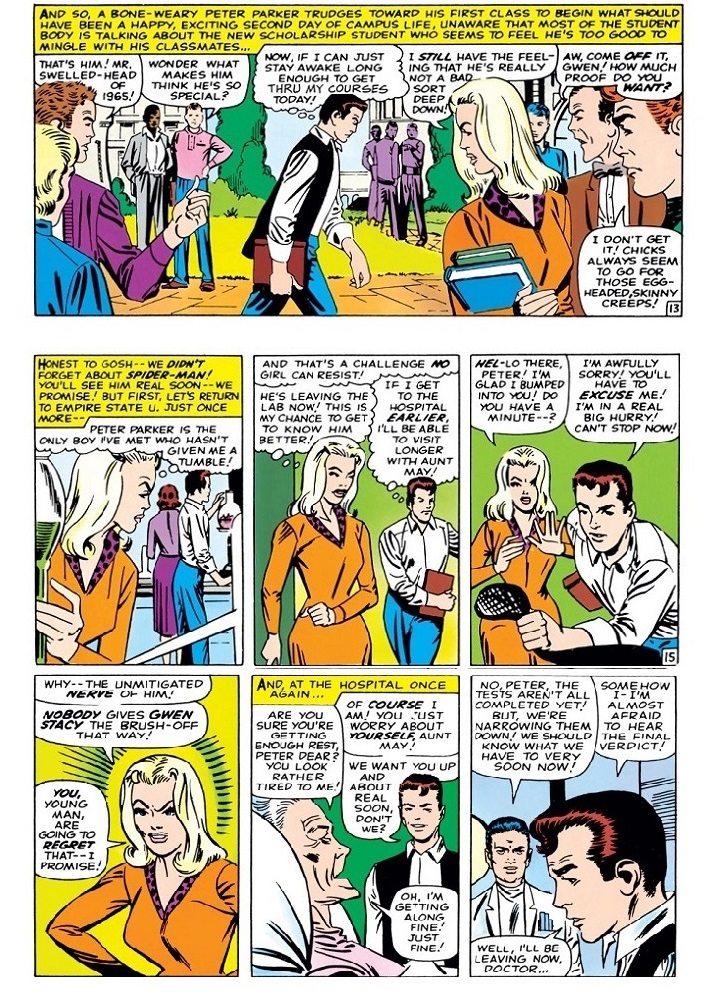
The Amazing Spider-Man #31 (Dec. 1965). Stan Lee, script; Steve Ditko, plot and art.
For the next several issues, it was mostly a back-and-forth, lighthearted “she likes him, now she doesn’t” interaction.
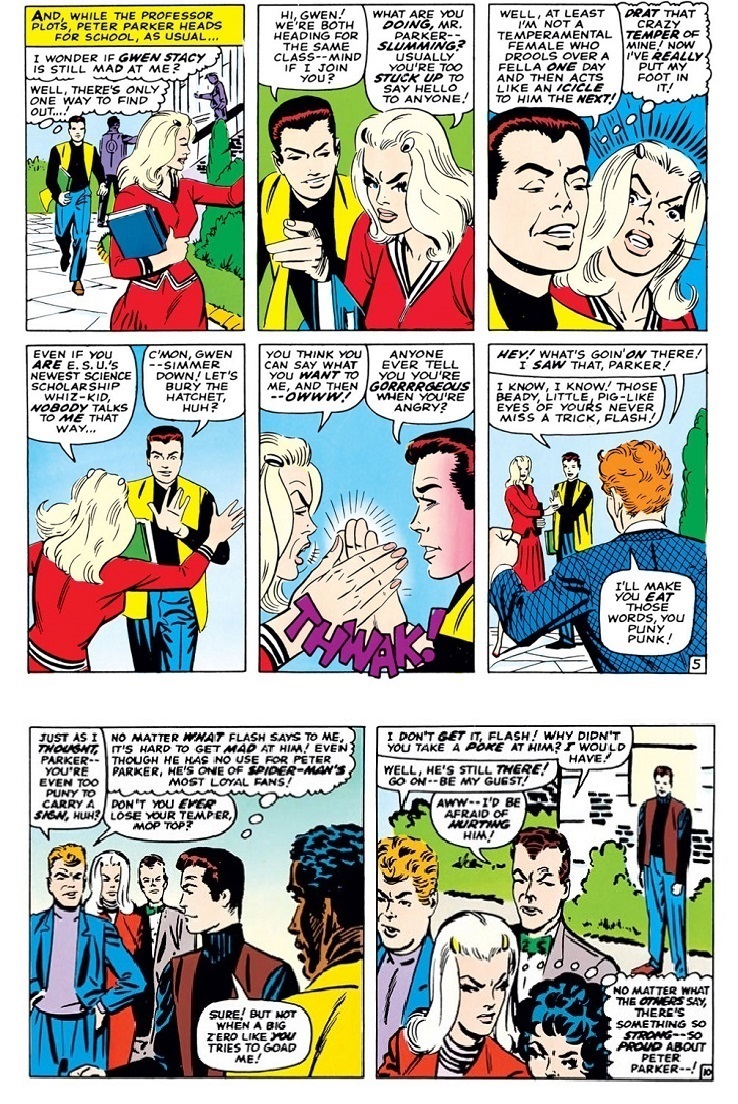
Top two tiers, The Amazing Spider-Man #37 (June 1966). Bottom tier, The Amazing Spider-Man #38 (July 1966). Both are Lee, script; Ditko, plot and art.
Stan Lee was the writer and Steve Ditko the plotter/artist on the title when Gwen was first introduced, and then John Romita took over the art with ASM #39 (Aug. 1966). Gwen’s haughty appearance and attitude that had been present under Ditko quickly softened and she became more youthful, attractive… and emotionally available. Of course, there was still a problem, and his name was Peter Parker. Early in the Romita run, Peter was trying to convince Betty Brant to move on for her own good (she hated Spider-Man). During this time, Gwen was basically eye-candy in the background.
Betty Brant made a return to New York (in ASM #41, Oct. 1966) and had a reunion with Peter, but both realized whatever feelings they had for each other in the past were gone… which freed him up for a new love interest. And just when you thought it was going to be Gwen, the dazzling Mary Jane Watson entered his life at the end of the next issue (ASM #42, Nov.1966). And Gwen, who was still running hot and cold toward him, suddenly realized when seeing MJ and Peter together a few issues later that Peter was a hot commodity:
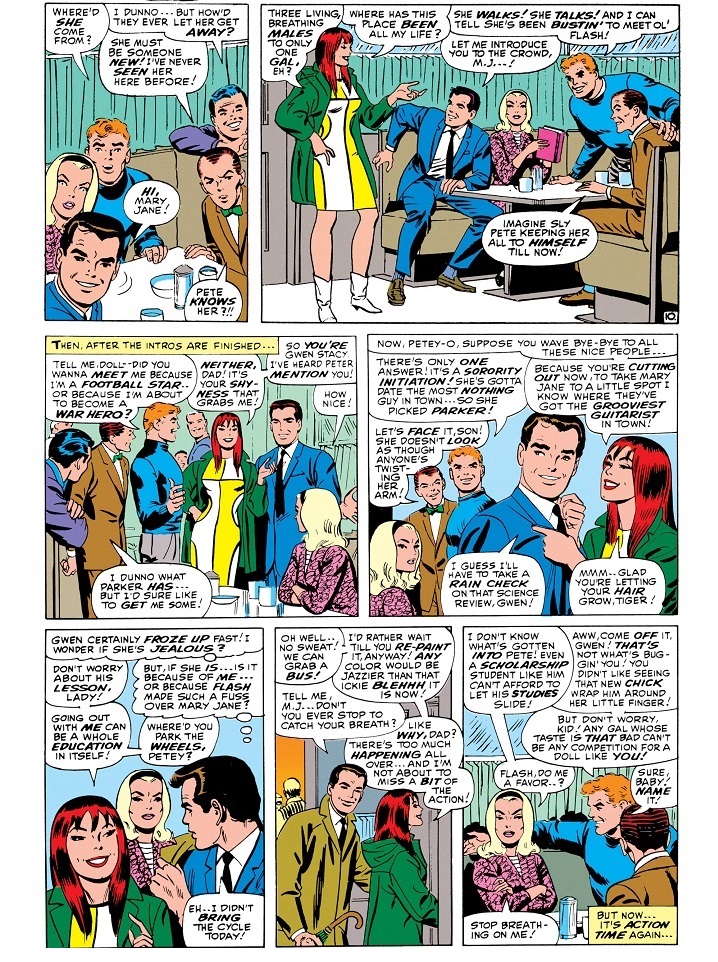
The Amazing Spider-Man #44 (Jan. 1967). Lee, script; John Romita, art.
Unbeknownst to Ms. Stacy, Peter really did like Gwen better. From ASM #45 (Feb. 1967), “It’s funny the way I keep thinking of Gwen, even though I’ve never really dated her. Mary Jane always seems to pop up between us.” Light flirtations continued between Peter and Gwen, but inside they were starting to feeling a lot more:

Top two tiers, The Amazing Spider-Man #50 (July 1967). Bottom tier, The Amazing Spider-Man #51 (Aug. 1967). Both are Lee, script; Romita, pencils; Mike Esposito, inks.
Their growing relationship remained a subplot to the main Spidey stories until ASM #57 (Feb. 1968) when it exploded to the forefront. Spider-Man had developed amnesia a few issues before and Gwen, worried sick about the disappearance of Peter, asked her father, ex-Police Captain George Stacy, to help locate him. Later, she went to police headquarters, and discovered Spider-Man there and flew into a tearful rage against him. Peter regained his memory later and accompanied Captain Stacy to his home (in ASM #59, Apr. 1968), where Gwen threw herself into his arms:
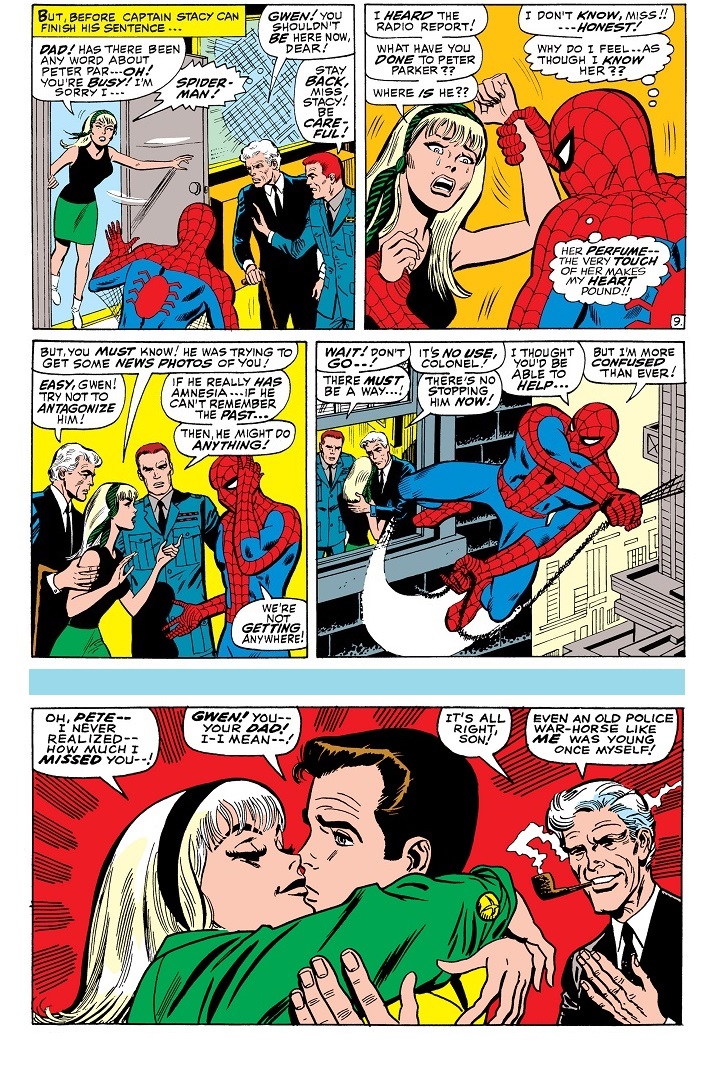
Top two tiers, The Amazing Spider-Man #57 (Feb. 1968). Bottom tier, The Amazing Spider-Man #59 (Apr. 1968). Both are Lee, script; Romita, pencils; Esposito, inks.
Romance at last. Or so it would be if anyone but Stan Lee were writing it, for further on in that same issue the Kingpin brainwashed Captain Stacy into joining his criminal activities. Later, Peter visited the Stacy home and told the Kingpin-controlled Captain Stacy that he is aware of what happened. Stacy tried to attack Peter, but Peter’s reflexes blocked the blow and he accidentally shoved Stacy to the floor — just as Gwen entered the room. (Luckily, several heartbreaking issues later, Captain Stacy returned to normal and told Gwen that Peter was not at fault.)
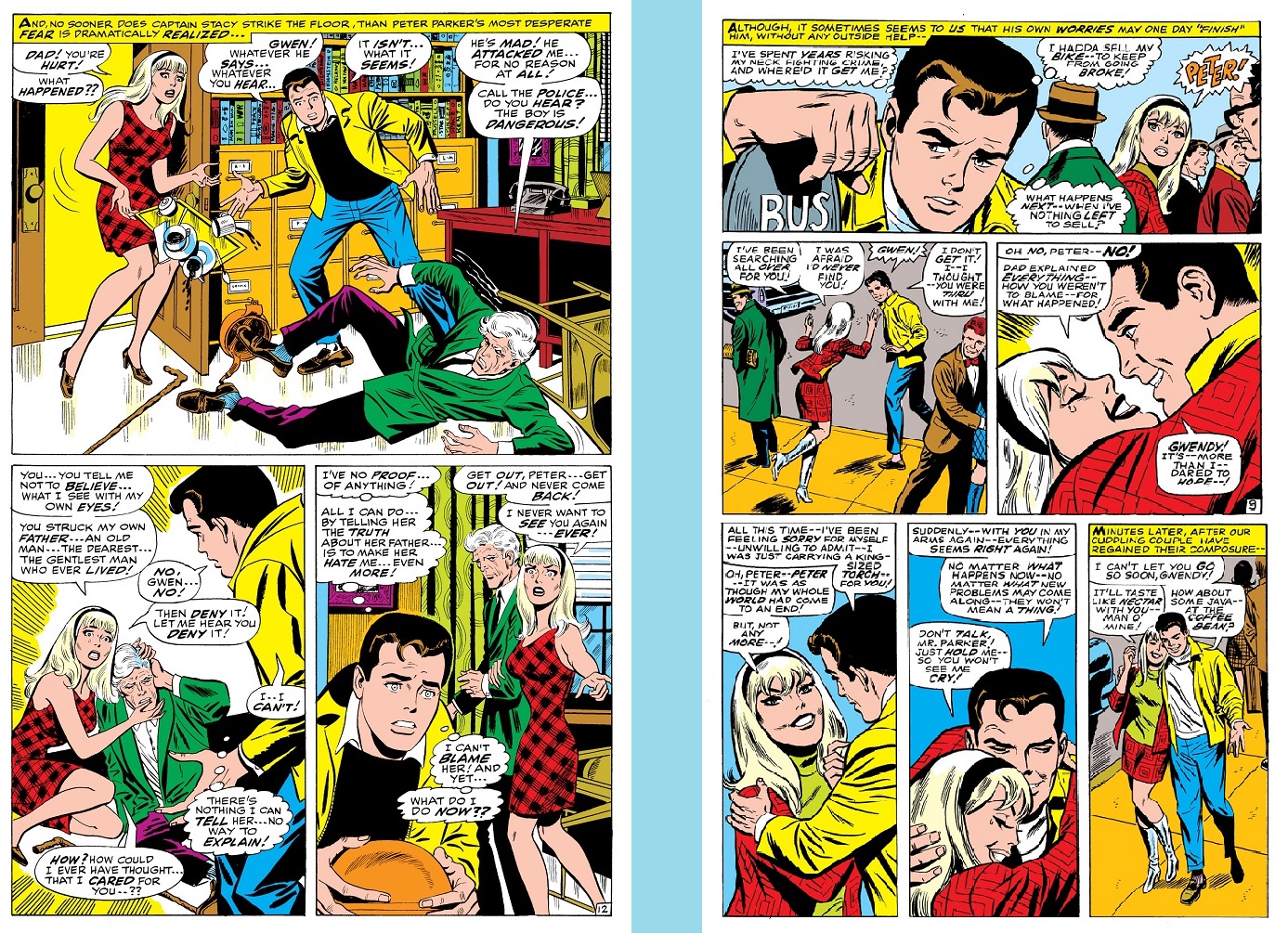
Left, The Amazing Spider-Man #60 (May 1968). Right, The Amazing Spider-Man #66 (Nov. 1968). Both are Lee, script; Romita, layouts; Don Heck, pencils; Esposito, inks.
Peter’s relationship with Gwen was tumultuous, but never did he have someone who loved him so much. As she earlier told Aunt May, Gwen felt as weak as a kitten whenever she was with him. We would also see Gwen fight like a tigress against anyone who belittled him.
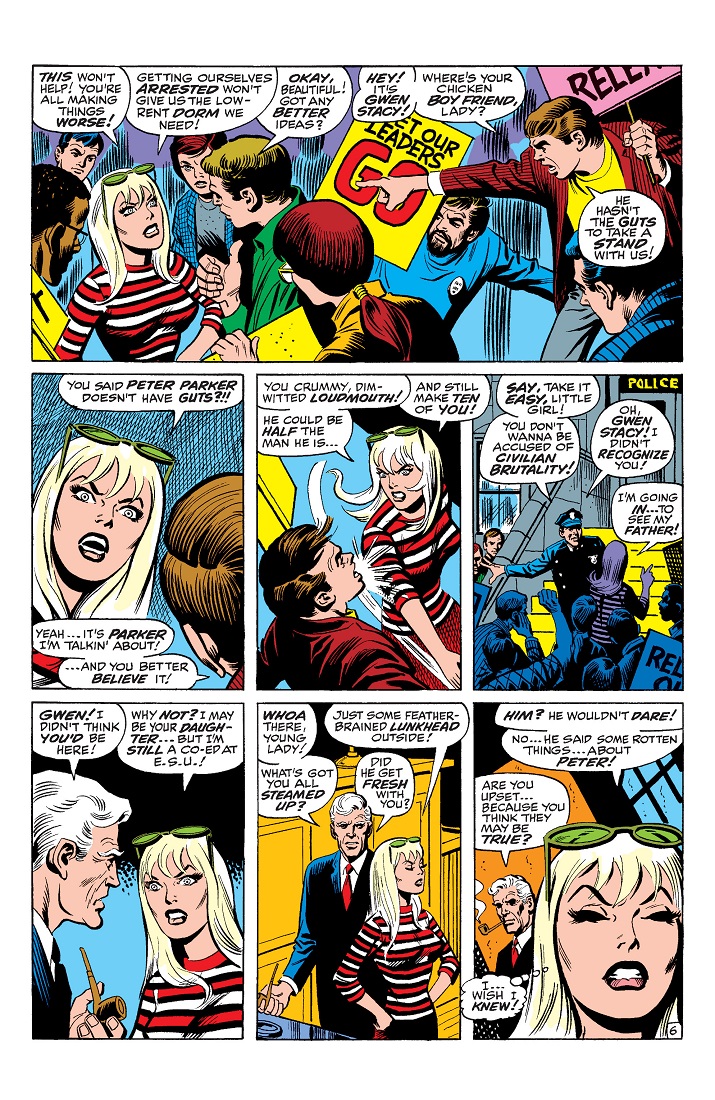
The Amazing Spider-Man #69 (Feb. 1969). Lee, script; Romita, plot and layouts; pencils; Jim Mooney, pencils and inks.
However, the greatest pain Gwen was ever to know was when her father gave his life to save a child from falling rubble during from a rooftop fight between Spider-Man and Doctor Octopus in ASM #90 (Nov. 1970). Spider-Man tried taking him to medical help but it was too late and Captain Stacy’s last words were to the young man he knew was behind the mask:
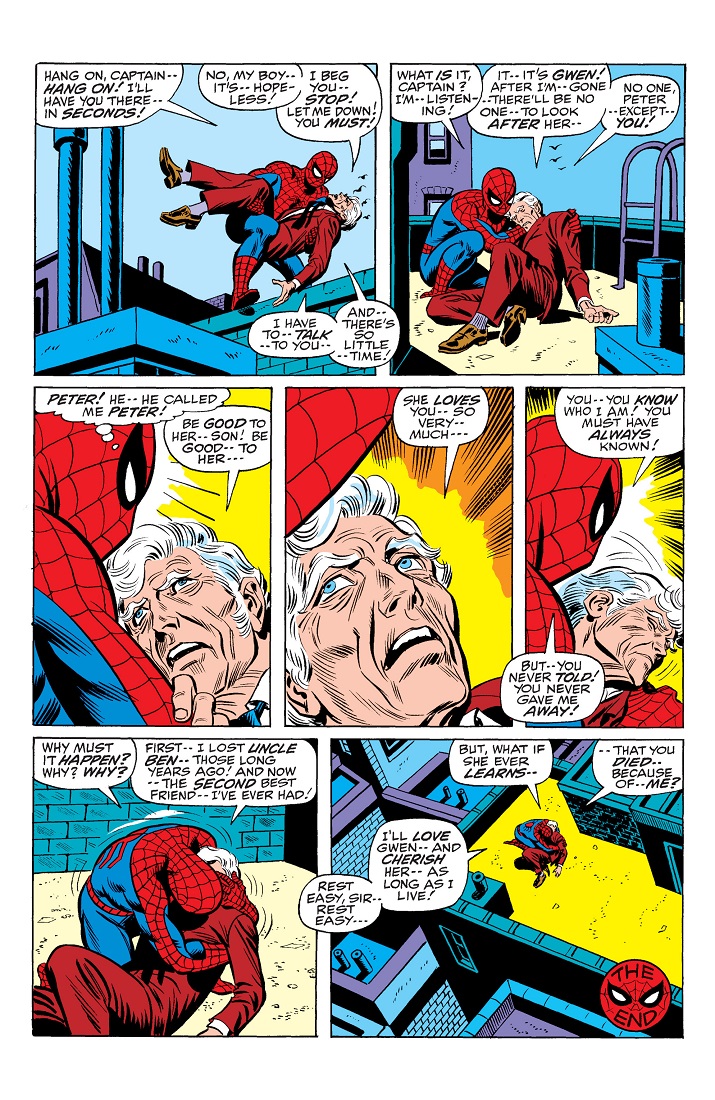
The Amazing Spider-Man #90 (Nov. 1970). Lee, script; Gil Kane, pencils; Romita, inks.
Gwen blamed Spider-Man for her father’s death and turned to Peter to be there for her, but he was afraid of what would happen if she discovered he was the man she hated. Emotionally hurt, she accepted an offer to stay with relatives in England. Peter did fly to London after her (in ASM #95, Apr. 1971) but that old Peter Parker luck followed him and as soon as his plane landed it was announced there was a terrorists’ bomb on the steps next to it.
Changing to Spider-Man, he saved the passengers and then rescued a kidnapped American diplomat and his young son. Needless to say, Spider-Man got on the news. Peter dared not go to Gwen then because his being there at the same time as Spider-Man would be too much of a coincidence. He returned to New York without her ever knowing he had flown there to be with her. However, after several issues of being apart, she could not stand being away from him:
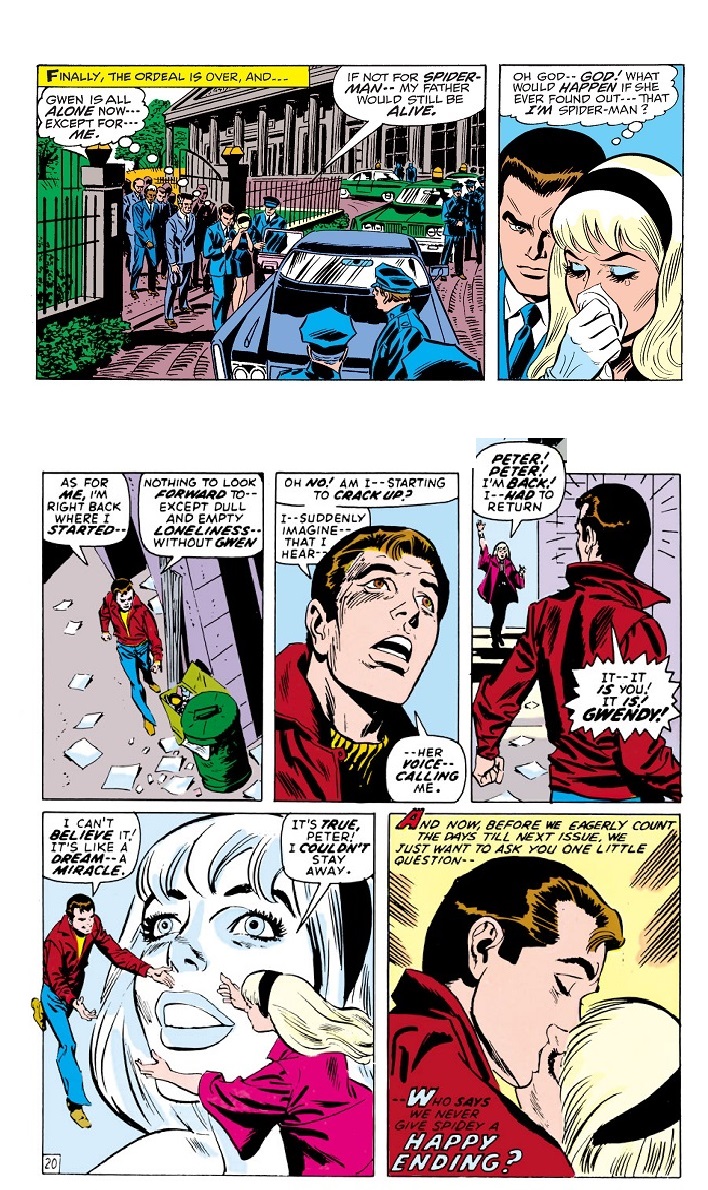
Top tier, The Amazing Spider-Man #91 (Dec. 1970). Lee, script; Kane, pencils; Romita, inks. Bottom two tiers, The Amazing Spider-Man #98 (July 1971). Lee, script; Kane, pencils; Frank Giacoia, inks.
As we all know, the words at the end of that storyline about a “Happy Ending” did not last long. Following ASM #110 (July 1972), Stan Lee left the writing of the series to Gerry Conway and John Romita. With ASM #120 (May 1973), it went to Gerry Conway solo, which included the heartbreaking story (possibly the most famous in Spider-Man history) in The Amazing Spider-Man #121 (June 1973), “The Night Gwen Stacy Died.”
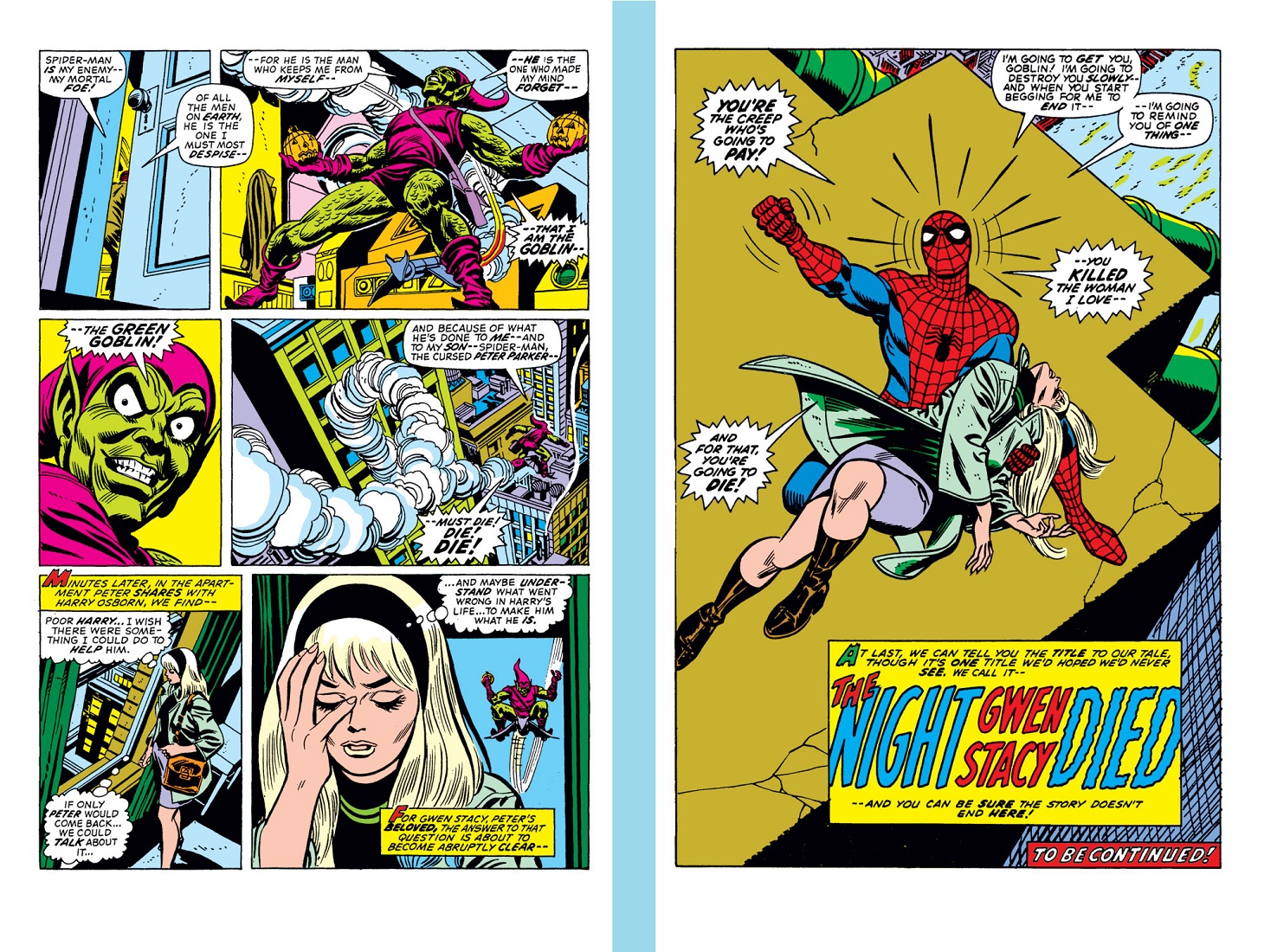
The Amazing Spider-Man #121 (June 1973). Gerry Conway, script; Kane, pencils; Romita and Tony Mortellaro, inks.
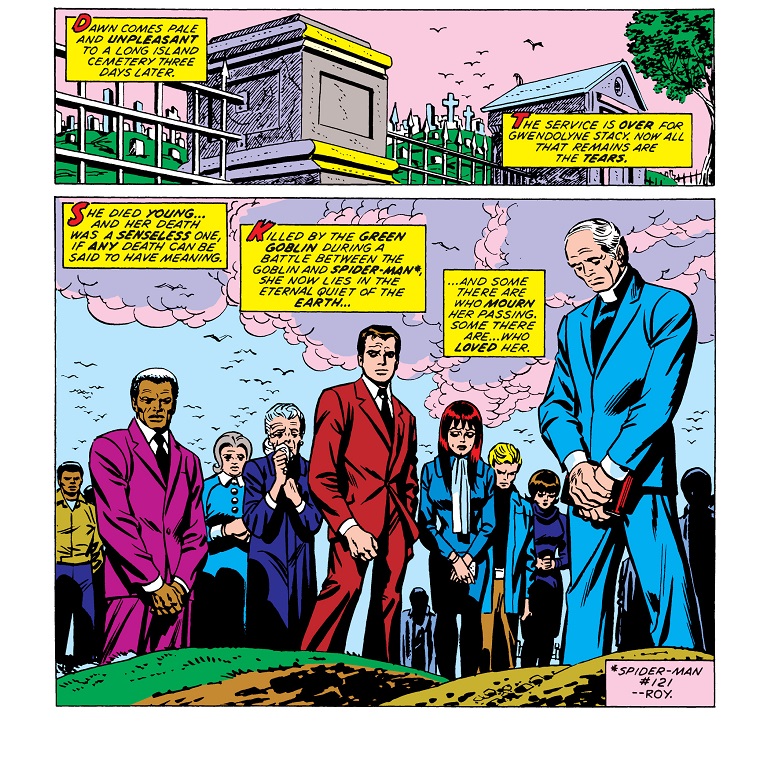
The Amazing Spider-Man #123 (Aug. 1973). Conway, script; Kane and Romita, pencils; Romita and Mortellaro, inks.
Whose decision was it for Gwen Stacy to die has been wondered about for some time, but the letter column for ASM #125 (Oct. 1973) stated, “We gotta be honest and admit that it wasn’t Gerry’s idea alone. … Gerry had been reading over the past few years’ issues and had come to the conclusion that something was wrong — or, more accurately, missing. The relationship between Pete and Gwen had been through a lot of inconsequential ups and downs, and unless the two were to be married, there was nowhere else to take it. But marriage seemed wrong, too. Peter just wasn’t ready. So Gerry, Roy, and Stan debated the question long and hard… and it turned out that all had reached the same inescapable conclusion. Gwen’s death was simply fated to happen.”
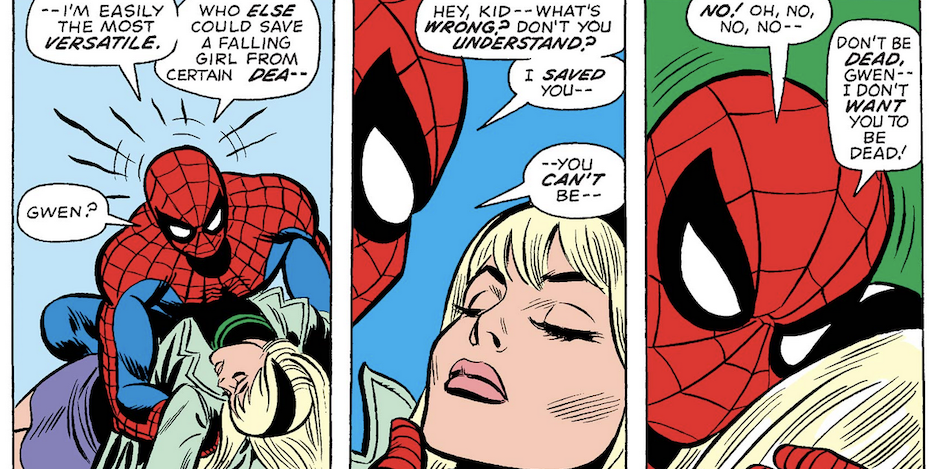
ASM #121
There was a What If? issue (#24, Dec. 1980) in which Peter did save her, but things still turned out bad for him and those he cared about. And number of other Gwens have popped up over the decades — some clones, some from other Earths — but the real Gwen was one of the few Marvel characters to stay dead. Until a few months ago.
In the November 2022 issue of The Amazing Spider-Man Vol. 6 #10 (or, as Marvel said on the cover, #904 in legacy numbering), Peter was allowed by a celestial named Progenitor to have a few moments of closure with the real Gwen, still the young age she was when she died, and then she vanished into the ether. Speaking for this long-time Gwen Stacy fan, I am grateful he (and we) had that chance.
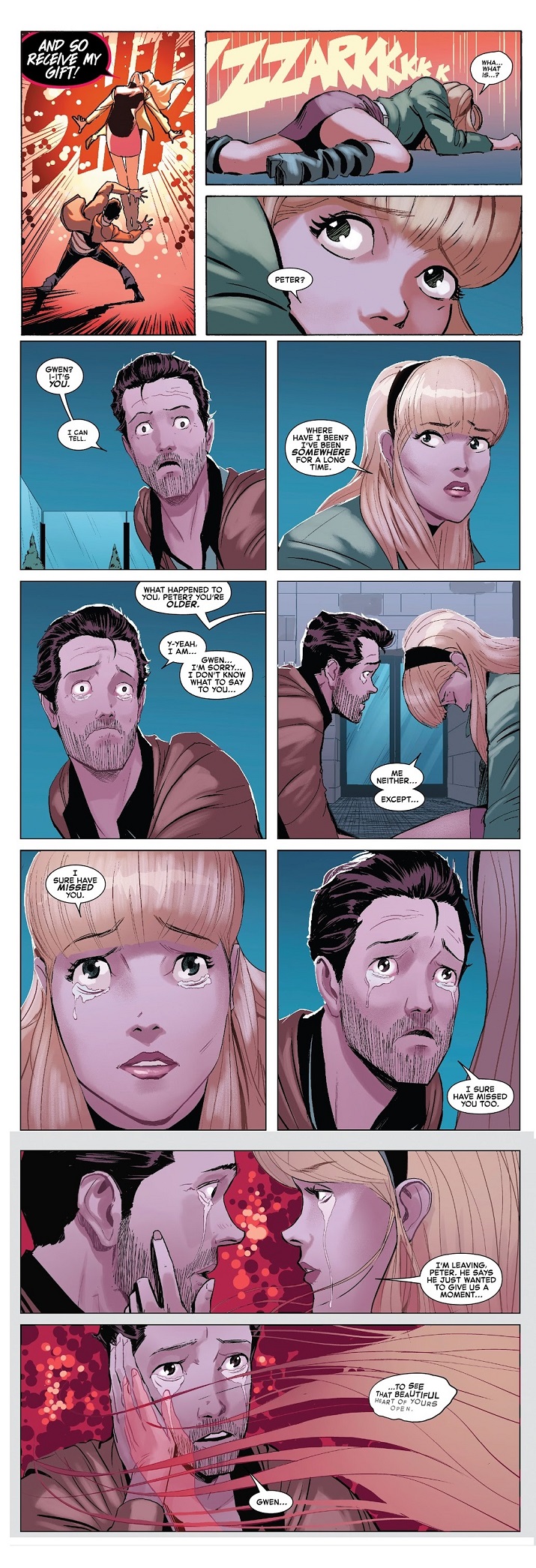
The Amazing Spider-Man #904 (aka Vol. 6, #10) (Nov. 2022). Zeb Wells, script; Nick Dragotta, art.
—
MORE
— AMAZING SPIDER-MAN #121 and the TOP 13 COVERS of MARCH 1973 — RANKED. Click here.
— How a Golden Age Comic Strip Helped Inspire the DEATH OF GWEN STACY. Click here.
—
PETER BOSCH’s first book, American TV Comic Books: 1940s-1980s – From the Small Screen to the Printed Page, has just been published by TwoMorrows. He has written articles and conducted celebrity interviews for various magazines and newspapers. Peter lives in Hollywood.


March 13, 2023
Still heartbreaking after all these years!
March 13, 2023
Something else worth noting in the closure sequence besides her age…the artist and the writer have her in the clothes she wore when she died. Compare to the images from #121. That amount of caring about the details is touching.
March 13, 2023
Very well said. I didn’t know about the recent story you mentioned. I am unfortunately aware of a story by a very famous writer who decided to muck up Gwen’s good name just for shock value. Editors really need to rein those guys in some times. That’s not in my head canon!
March 13, 2023
Chris, I know the story you mean. And it was awful. Happily, though, in 2021 it was shown to be a lie.
March 13, 2023
Great recap of perhaps the greatest, richest love story in comics history. It gets me every time.
March 18, 2023
Nice recap but factually incorrect on who suggested Gwen’s death: it was John Romita Sr who concluded that the arc of Gwen’s story was running out. Gerry wanted to kill someone off, Romita pulled the trigger.
March 23, 2023
Werner, if you re-read the paragraph above the pages of her death, I never said Conway was responsible. I said he wrote the story (which is correct).
And below the pages, I quote from ASM #125 on what Marvel had to say about whose decision it was.
June 14, 2023
Excellent re-cap, thank you. I read this story when it first came out, but I think I missed a few issues of their early relationship. I’ll look through my old books, and see where the gaps are. It’s so wonderful that we can now read comics online to fill the empty spaces.
I remember waiting for the writers to somehow “fix” Gwen’s death and wondering how they would do it. When they didn’t, I lost some of my dedication to Spider-man.
August 19, 2023
This is the first time I have ever read comments in this context. That’s so closely mirrored mine and said what I’ve always felt as well.. I too loved Gwen but even more the way she loved Peter and their love between them.
I don’t know how much space some permitted here, but I could write a very long article because I read this comic as a child in 73. When I was anticipating every month the new issue of spider-man I was about 8 years old when I read this as it was a brand new issue.. so there is a version of mead stuck in time connected to this story and this comic and then there’s the adult in me that has had relationships come and go and understands things on a bigger picture. Not to mention understanding this is a comic strip. So there’s two sides of the coin for this on me, but the review on this and the way it was expressed connects both sides of that coin for me that to this day.. when I read the original or see these even as a grown man I can still feel the child in me in shock and also wondering how they would fix this because nobody dies especially Gwen. I had been waiting with anticipation the similar ways Peter and Gwen had when they were trying to reconnect from the trip to London when they both needed to talk to each other and that never came to pass which makes it all the more heartbreaking. Then you add in the uncertainty of him blaming himself over the years of not really sure if she was already dead or the result was the snap which seems to be the consensus at this point in history. Add to that that it wasn’t too long from when her father died knowing that Peter was Spider-Man and I am tearing up typing this as it has become part of me while the adult in me feels ridiculous understanding how important it is for a writer to write something that is memorable that change this character forever. But the other part of me that says anybody but her. It’s clear when the writing team were writing this that they were oblivious to how strong the fans felt about Peter and Gwen. I understand they had nowhere to go but marriage with them and they wanted to retain his youth from a story stamp point. It still doesn’t mean it hurts like hell even now 50 years later.
Perhaps it’s the child in me that was faced with death and that child died on that bridge with her 50 years ago. I too like Peter… Never stopped mourning her loss.
Epilogue and adult soapbox moment- I hate how the multiverses, the clones and all of that have watered down over the decades, the realness of this relationship in the impact of her and them. With hulk worlds, multiple Spider-Man and pigs it has minimized. What makes these individuals special in the first place… To me, it’s lazy writing that has just been compounded by everybody adding to it over the years.. when I wish they would have just written him going into adulthood with me. Yes that is the 50 plus year old man bitching about the kids in my yard and change..